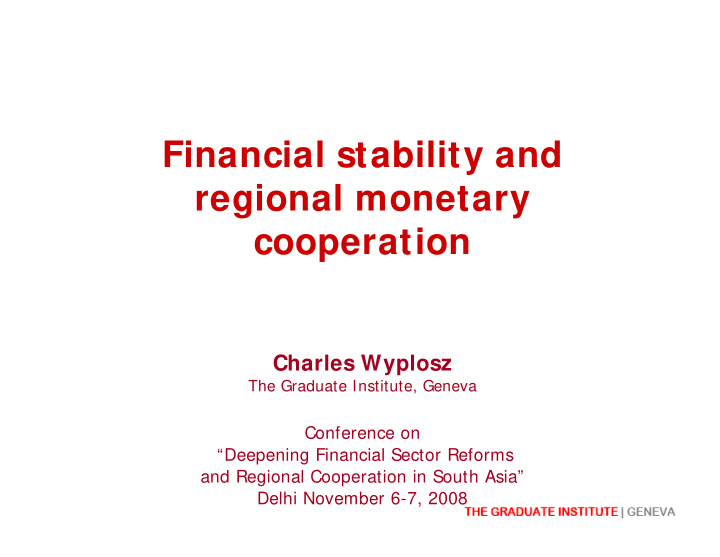



Financial stability and regional monetary cooperation Charles Wyplosz The Graduate Institute, Geneva Conference on “Deepening Financial Sector Reforms and Regional Cooperation in South Asia” Delhi November 6-7, 2008
The issues • Incredible timing! • Financial turbulences and exchange rates • The Asian and European experiences compared • Note: so far mostly East Asia
Financial turbulences and the exchange rate • Massive crisis • Yet no exchange rate tensions within European monetary union • The dog that didn’t bark • Elsewhere?
Financial turbulences and the exchange rate Non members of the euro area 100 Czech koruna UK pound sterling Hungarian forint Polish zloty Romanian leu Swedish krona 70 2006Jan 2006Jul 2007Jan 2007Jul 2008Jan 2008Jul
Financial turbulences and the exchange rate Some Asian countries 100 Indian rupiah Indonesian rupiah Korean won (Republic) Malaysian ringgit Philippine peso Thai bhat 70 2006Jan 2006Jul 2007Jan 2007Jul 2008Jan 2008Jul
The Asian and European experiences • Exchange rate agreements � Linchpin of European integration � Absent in Asia • Mutual support � Unlimited under ERM and automatic in euro area � Web of limited bilateral swap agreements under Chiang Mai initiative
Chiang Mai initiative Amount as of b Bilateral Swap Conclusion Currencies Arrangements (BSA) a dates May 30, 2004 Apr 1. 2008 Small Japan-Korea c US$2 bn. d US$/Won (one-way) Jul 04 2001 Japan-Korea US$/local (two-way) Feb. 23 2009 US$15 bn. amounts Japan- Korea Yen/Won (two-way) Jul 3 2010 US$6 bn. Japan-Thailand c US$/Baht (one-way) Jul 30 2001 US$3 bn. relative Japan-Thailand US$/local (two-way) US$9 bn. Nov 8 2010 Japan-Philippines c to reserves US$/Peso Aug 27 2001 US$3 bn. Japan-Philippines US$/local (two-way) May 3 2009 US$6.5 bn. US$1 bn. d US$1 bn. d Japan-Malaysia US$/Ringgit (one-way) Oct 04 2007 Japan-China Yen/ RMB (two-way) Sep 20 2010 US$6 bn. US$6 bn. Japan-Indonesia c US$/Rupiah (one-way) Feb 17 2003 US$3 bn. Normal Japan-Indonesia US$/Rupiah (one-way) Aug 30 2008 US$6 bn. Japan-Singapore c US$/Sing.$ (one-way) Nov 10 2003 US$1 bn. if no Japan-Singapore US$/local (two-way) Nov 07 2008 US$4 bn. Korea - China c surveillance Won/ RMB (two-way) Jun 24 2002 US$4 bn. Korea - China Won/RMB (two-way) Jun 23 2010 US$8 bn. Korea-Thailand US$/local (two-way) Dec 11 2007 US$2 bn. US$2 bn. Korea-Malaysia c US$/local (two-way) Jul 26 2002 US$2 bn. But what Korea-Malaysia US$/local (two-way) Oct 13 2008 US$3 bn. Korea-Philippines c US$/local (two-way) Aug 09 2002 US$2 bn. anchor? Korea-Philippines US$/local (two-way) Oct 16 2010 US$4 bn. Korea-Indonesia US$/local (two-way) Dec 26 2009 US$2 bn. US$4 bn. China-Thailand US$/Baht (one-way) Dec 05 2004 US$2 bn. US$2 bn. China-Malaysia c US$/Ringgit (one-way) Oct 08 2005 US$1.5 bn. US$1.5 bn. China-Philippine RMB/Peso (one-way) Apr 9 2010 US$1 bn. US$2 bn. China-Indonesia Rupiah/RMB (one-way) Dec 03 2003 US$1 bn. China-Indonesia US$/Rupiah (one-way) Oct 16 2009 US$4 bn.
The Asian and European experiences • Exchange rate agreements � Linchpin of European integration � Absent in Asia • Mutual support � Unlimited under ERM and automatic in euro area � Web of limited bilateral swap agreements under Chiang Mai initiative • Enlargement to India, Australia, New Zealand under consideration
The anchor issue • Cooperation and mutual support need an anchor/yardstick � Europe relied on exchange rate agreements • Objective criteria • Automatically calls for coordination � Asia relies on soft surveillance • ERPD: no clear criterion • Therefore conflictual
The Asian and European experiences • Financial market integration � Europe: opening to competition • integrate into world markets • market driven � Asia (ABMI): regional-defensive • develop internal markets • government-led institutions
Conclusion: the mirage of foreign exchange reserves Even the Greenspan-Guidotti rule is not fail-safe! Foreign exchange reserves/GDP Foreign exchange reserves/Gross liabilities 0.6 1.4 China China 1.2 India India Korea Korea 1 0.4 0.8 0.6 0.2 0.4 0.2 0 0.0 1970 1974 1978 1982 1986 1990 1994 1998 2002 2006 1970 1974 1978 1982 1986 1990 1994 1998 2002 2006
Conclusion: the mirage of foreign exchange reserves • Foreign exchange reserves � Can deter moderate speculative attacks � Will never be a 100% guarantee • Exchange rates remain a fatal hazard � For net debtor countries � Even for net creditor countries • Gross vs. net liabilities � The ‘original sin’ problem will not go away • But deep regional cooperation does help
Recommend
More recommend